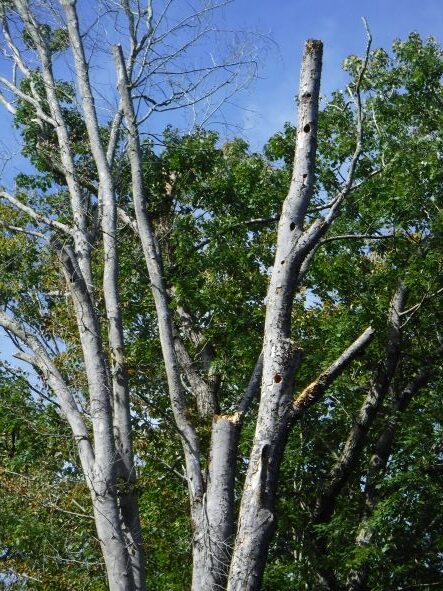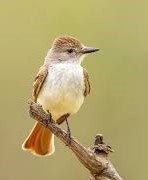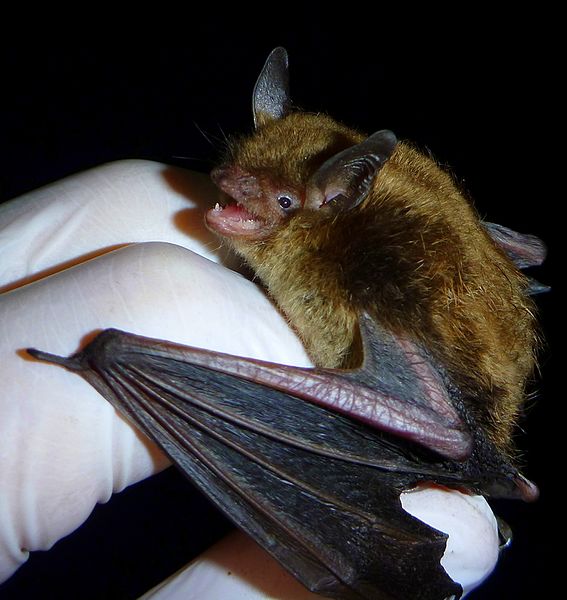In an earlier blog about tree extinctions, I commented that less drastic impacts by pests can also be important. I mentioned specifically that clumps of beech root sprouts cannot duplicate the quantities of nuts and cavities provided by mature beech trees.
This thought prompted me to search for information about use of tree cavities by wildlife. The articles I have found are decades old and largely focus on implications for management of forests for timber. Timber production conflicts with a goal of ensuring the presence of large (“overmature”), trees, especially those with dead branches, and completely dead trees (“snags”). These articles were written too long ago to address the possible impacts of non-native insects and pathogens – although there is some discussion of widespread mortality of pines caused by the mountain pine beetle.
These sources make clear that species that make cavities are keystone species. Many other wildlife species depend on them — birds, bats and terrestrial animals – mammals and herps. Furthermore, these cavity-associated species require forests with significant numbers of large, old, declining trees. When non-native insects or pathogens kill those trees, there might be a short-term bonanza of dying trees – suitable for nesting and foraging; and wood-feeding insects to provide food. But afterwards – for decades or longer – there will probably be small-diameter trees, and different species. Can the cavity-dependent species find habitat or food under these circumstances?
[By coincidence, the PBS program “Nature” broadcast an episode on woodpeckers on the 2nd of November! The title is “The Hole Story”. ]
Cavities provide a variety of habitats for many species – including some not usually thought of as “forest” species. Among the 85 North American bird species identified by Scott et al. as associated with cavities are seven species of ducks, two vultures, three falcons, 12 owls, two swifts, six flycatchers, two swallows, purple martin, seven chickadees, three titmice, four nuthatches, brown creeper, five wrens, three bluebirds, and two warblers. They point out that the majority of these birds are insectivores. Woodpeckers are especially important predators of tree-killing bark beetles.
Goodburn and Lorimer found that more than 40 species of birds and mammals in hardwood forests of Wisconsin and Michigan use cavities in snags and dead portions of live trees for nest sites, dens, escape cover, and winter shelter. Bunnell reported that 67 vertebrate species commonly use cavities in the Pacific Northwest. Chepps et al., Daily et al., and Wiggins focus on specific species in the Rocky Mountains. (Full citations for all sources are at the end of the blog.)
While Scott et al. (published in 1977) do not address the impact of non-native pests, their profiles of individual bird species sometimes name specific types of trees favored. Several of these tree taxa have been decimated by such non-native pests, or face such attack in the near future. Thus, concern appears warranted for:
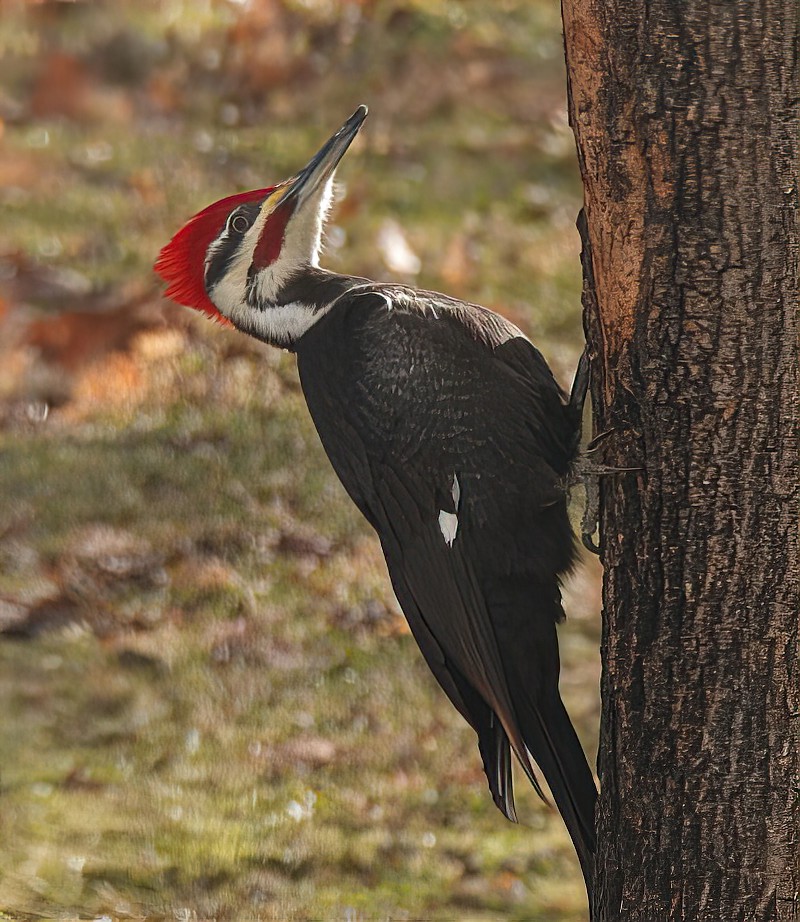
- birds nesting in American elm, including two that are quite large so they require large trees to accommodate their nests: common goldeneye (a duck) and pileated woodpecker (larger than a crow).
- the pileated woodpecker also nests in ash and beech and here
- the yellow-bellied sapsucker nests in butternut.
How many species depended on American chestnut, which – before the blight — grew to diameters up to 5 feet, heights of 70 to 100 feet, and had hollow centers (USDA 2022)?
In the West, some nesting tree species are under imminent threat from invasive shot hole borers, goldspotted oak borer, or sudden oak death. Detection of the emerald ash borer in Oregon portends a longer-term threat. Birds likely to feel these impacts include the acorn woodpecker, ash-throated flycatcher, and purple martin. The golden-fronted woodpecker is associated with oaks in parts of Texas where oak wilt is severely affecting live oaks.
At the beginning of the 21st Century – before widespread mortality caused by the emerald ash borer — densities of snags in the managed forests in the Lake States were apparently already insufficient to sustain population densities of cavity nesting birds. Pileated woodpeckers and chimney swifts both prefer snags greater than 50 cm dbh, which are significantly less abundant in harvested stands. For six of eight bird species studied, the number of breeding pairs was significantly higher in old-growth northern hardwood stands than in those under management (Goodburn and Lorimer).
Strong Primary Excavators are Keystone Species
Cavity nesters are commonly divided into:
1) primary excavators that excavate their own cavities. These are further divided into strong excavators – those species that forage by drilling, boring, or hammering into wood or soil; and weak excavators – those species that probe or glean bark, branches, and leaves to acquire prey.
2) secondary cavity users, that use holes made by primary cavity excavators (Bunnell).
Strong primary excavators tend to be large, e.g., most woodpeckers, sapsuckers, and the northern flicker. Weak excavators are mostly smaller species, such as chickadees and nuthatches; plus those woodpeckers that forage primarily by probing and gleaning, extracting seeds, or capturing insects in flight [e.g., acorn woodpecker (Melanerpes formicivorus), downy woodpecker (Picoides pubescens)] (Bunnell).
Bunnell considers strong excavators to be keystone species because so many other cavity users depend on them. Their loss would seriously disrupt forest ecosystems. For example, in the Pacific Northwest, only nine of 22 avian primary excavators are strong excavators. Another 45 species are secondary cavity users. These include waterfowl, tree swallows, and some mammals such as flying squirrels. Some cavity nesters support an even wider group of species: in the Pacific Northwest, at least 23 bird species, six mammal species, and numerous arthropods (nine orders and 22 families) feed on sap and insects collected at holes drilled by sapsuckers (Bunnell). [I discuss sapsuckers’ ecosystem role in greater detail later.]
Tree Characteristics
There is general agreement that animals dependent on tree cavities “prefer” (actually, require) trees that are large – tall, of large circumference, and sturdy – while having decayed interiors.
Size:
As Bunnell notes, larger snags provide more room and tend to stand longer without breaking, so they provide greater opportunities for cavity use. They also tend to be taller, so they offer higher nest sites that provide better protection from ground-dwelling predators. While larger-diameter trees remain standing longer regardless of the cause of mortality, snags created by fire usually fall sooner than do other snags. Beetle-killed trees are more attractive to cavity nesters that tend to excavate nest sites in trees on which they have foraged.
In the upper Midwest, cavity trees were a scare resource, even in unmanaged forests. Mean diameters for live cavity trees were twice as large as the mean diameter of the live trees in stands under a management regime. Such larger-diameter snags were more numerous in old-growth than in managed stands, especially in mixed hemlock-hardwood stands (Goodburn and Lorimer).
The Importance of Decay
Excavating a cavity demands considerable energy, so birds seek sites where a fungal infection has softened the interior wood. The exterior wood must remain strong to prevent collapse of the nest. These rots take time to develop, so they appear more often in older, even dying, trees. Bunnell, Scott et al., Chepps et al., and Goodburn and Lorimer all emphasize the role of decay in providing suitable cavity sites. Chepps et al. compared the aspen trees used by four species of cavity-nesting birds in central Arizona. Not only were nest trees softer than neighboring trees; they were softer at the spot where the nests were excavated than at other heights. [Spring (1965) provides a fun discussion of different species’ adaptations to the energy demands of hard pecking and climbing vertical trunks.]
Live v. Dead Trees
However, the need for decay does not necessarily mean birds prefer dead trees. Goodburn and Lorimer found that in Wisconsin and Michigan, a large percentage of all cavities found were in live trees.
Bunnell found that strong excavators select trees with less visible signs of decay. Where possible, secondary users will also use live trees. However, intense competition often forces them to use dead trees.
Hardwoods v. Conifers
Bunnell states that deciduous trees more often contain internal rot surrounded by a sound outer shell than do conifers (at least this is true in the Pacific Northwest). He found that cavity nesters chose hardwoods for 80–95% of their nest sites even where hardwoods comprised only 5–15% of the available tree stems. He concluded that availability of living hardwoods had a significant influence on strong excavators in the West, although probably was less important in hardwood stands in the East.
Taxa Dependent on Other Types of Cavity
Some species depend on cavities created by forces other than bird excavations, such as decay or fire. These include most of the mammals, especially the larger ones e.g., American martens, fishers, porcupines, and black bears. These natural cavities are often uncommon. Vaux’s swifts nest and roost in hollow snags large enough that they can fly in a spiral formation to enter and leave (Bunnell).
Bats are a special case. Bats are unique among mammals of their size in having long lives, low reproductive rates, and relatively long periods of infant dependency. They also play a key ecological role as the major predators of nocturnal flying insects (van den Driesche 1999). Also many species are in perilous conservation status: half of the 16 bat species in British Columbia were listed as threatened or endangered as of 1998 (van den Driesche). This was before the deadly disease whitenose syndrome had been detected in North America.
Bats require larger trees. In the Pacific Northwest at least, that choice often means conifers (Bunnell). Roosts are difficult to find, so samples are small. A study on the west coast of Vancouver Island (van den Driessche), located only nine roosts despite searching during three summers. Five roosts were in large-diameter (old) western red cedar, with dead tops and extensive cracks.
Brown creepers and some amphibians and reptiles nest or seek cover under slabs of loose bark, which are typically found on dead or dying trees. The same large, mature and old-growth conifer trees also provide preferred foraging habitat, since there is a higher density of arthropod prey on their deeply furrowed bark. While Wiggins (2005) studied bird populations in the Rocky Mountains, he cited studies in the eastern United States, specifically in the Blue Ridge and Allegheny mountains, that have found similar results. Goodburn and Lorimer found that in National forests in Wisconsin and Michigan, only 15% of trees consisted of the necessary snags with loose bark plates. Suitable trees were most frequent old-growth hemlock-hardwood stands, and on larger-diameter snags. A high proportion of the snags with loose bark were yellow birch (Betula alleghaniensis).
Importance of foraging sites
As Bunnell points out, a bird must feed itself before it can nest. Foraging trees and snags are usually smaller than nesting trees. Furthermore, birds need many more foraging sites than nesting sites. The situation perhaps most pertinent to our usual focus on invasive pests concerns bird species’ response to mountain pine beetle outbreaks. Red-breasted nuthatches and mountain chickadees increasing dramatically in apparent response to the beetle epidemic. When most of the conifers had been killed, and numbers of beetles diminished, numbers of these bird species also declined–despite the increased availability of conifer snags for nesting. Indeed, the birds continued to nest primarily in aspen during the epidemic.
Bunnell reiterates that snags of all sizes are needed; they provide perching, foraging, and hawking sites for bird species beyond cavity nesters as well as sustenance for bryophytes, insects, and terrestrial breeding salamanders. He says more than 200 studies reported harvesting of standing dead trees in beetle-killed forests had negative effects on bird, mammal, and fish species.
Other Dependencies – Food Sources
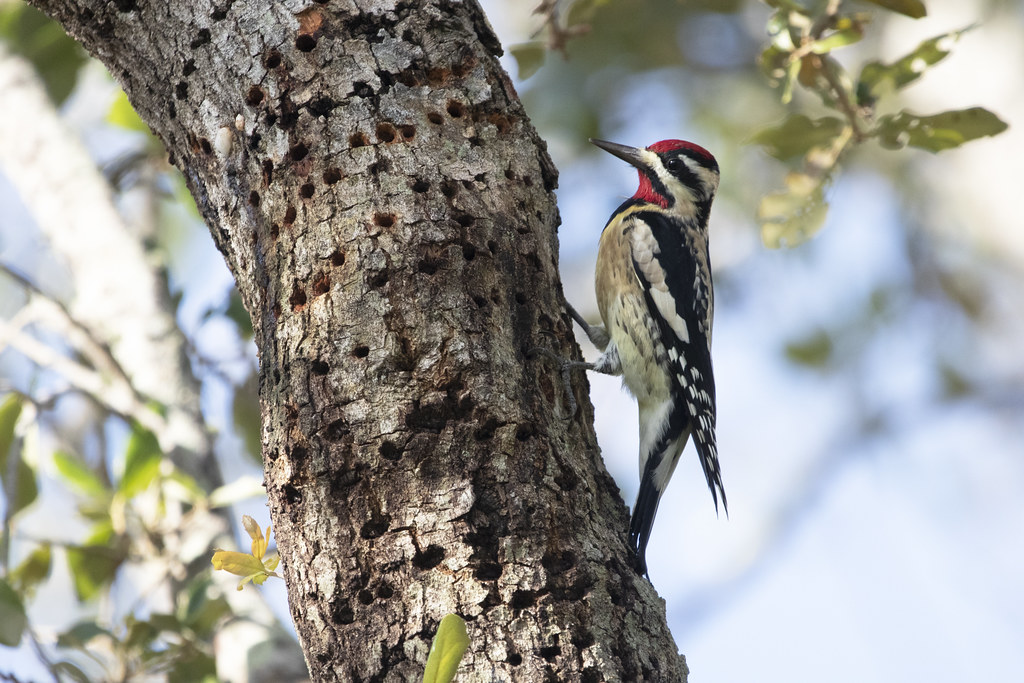
A few studies looked at the role of cavity-creating birds in providing food sources. The focus was on sapsuckers. They drill sapwells into trees’ phloem; sap flowing into these wells attracts many other species. In Michigan, Rissler determined that yellow-bellied sapsuckers’ sapwells attracted insects in seven orders and 20 families, especially Coleoptera, Diptera (other than Tephritidae), bald-faced hornets, and Lepidoptera. Daily et al. (1993) cites other studies showing that ruby throat and rufous hummingbirds have extended their breeding ranges by relying on these sapwells for nutrition in early spring before flowers open. [The “Nature” program covers this behavior.]
In a subalpine ecosystem in Colorado, Daily et al. found that red-naped sapsuckers support other species in two ways. First, they excavate nest cavities in fungus-infected aspens that are utilized by at least seven secondary cavity nesting bird species. When they feed, they drill sapwells that nourish more than 40 species – including hummingbirds, warblers, and chipmunks. Daily et al. called this a keystone species complex comprised of sapsuckers, willows, aspens, and a heartwood fungus. Disappearance of any element of the complex could cause an unanticipated unraveling of the community.
Goodburn and Lorimer looked at the availability of downed wood but did not discuss the implications of the presence of only small-diameter coarse woody debris.
Efforts to Accommodate Biodiversity Needs
Scott et al. reported in 1977 that the USDA Forest Service had required staff at regional and National Forest levels to develop snag retention policies. Twenty years later, Goodburn and Lorimer noted that Forest Service management guidelines for some Wisconsin and Michigan National forests since the early 1980s have called for the retention of all active cavity trees and 5-10 snags (larger than 30 cm dbh)/ha. However, as I noted above, they fear that these recommended snag retention levels might still be too limited to support cavity nesters. They found that two species that prefer snags greater than 50 cm dbh, pileated woodpeckers and chimney swifts, were significantly more abundant in old-growth than in selection stands. Furthermore, the number of breeding pairs of six species was at least 30% higher in old-growth northern hardwood than in selection stands and more than 85% higher in selection cuts than even-aged.
Goodburn and Lorimer cited others’ findings that removal of some live timber and snags in an Arizona ponderosa pine forest reduced cavity-nesting bird populations by 50%. Species affected were primarily violet-green swallows, pygmy nuthatches, and northern three-toed woodpeckers.
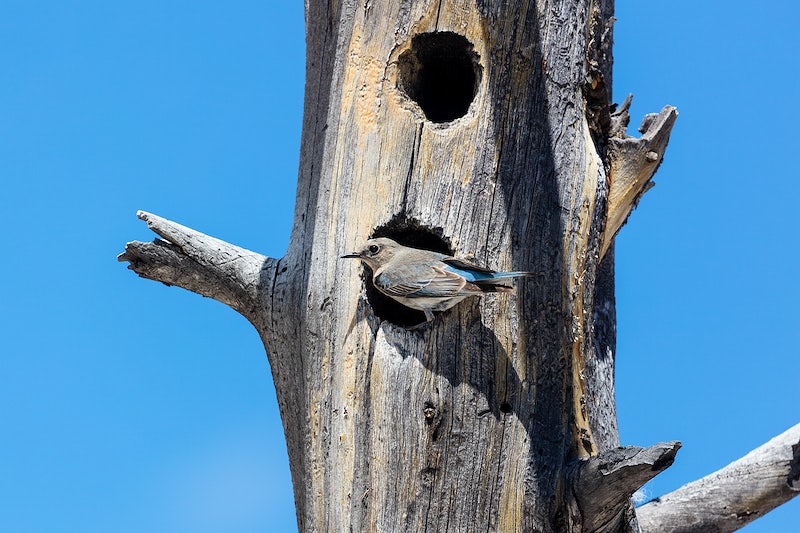
As I noted, none of these experts has addressed the impacts of wide-spread pest-caused tree mortality. If I may speculate, it seems likely that when the first wave of mortality sweeps through a forest, the result might be an expansion of both nesting opportunities (in dead or dying trees) and food availability for those that feed on wood borers. These would probably be more plentiful even in trees killed by pathogens or nematodes. Sapsuckers and those that depend on them might experience an immediate decline in sap sources. Over the longer term it seems likely that all cavity-dependent species will confront a much lower supply of large mature trees. I note that many deciduous/hardwood tree species are being affected by introduced pests.
Are there current studies in Michigan, where so many ash have died?
SOURCES
Bunnell, F.L. 2013. Sustaining Cavity-Using Species: Patterns of Cavity Use and Implications to Forest Management. Hindawi Publishing Corporation. ISRN Forestry. Volume 2013, Article ID 457698
Chepps, J., S. Lohr, and T.E. Martin. 1999. Does Tree Hardness Influence Nest-Tree Selection by Primary Cavity Nesters? The Auk 116(3):658-665, 1999
Daily, G.C., P.R. Ehrlich, and N.M. Haddad. 1993. Double keystone bird in a keystone species complex. Proc. Natl. Acad. Sci. USA Vol. 90, pp. 592-594, January 1993 Ecology
Goodburn, J.M. and C.G. Lorimer. 1998. Cavity trees and coarse woody debris in old-growth and managed northern hardwood forests in Wisconsin and Michigan. Can. For. Res. 28: 427.438 (1998)
Rissler, L.J., D.N. Karowe, F. Cuthbert, B. Scholtens. 1995. Wilson Bull., 107(4), 1995, pp. 746-752
Spring, L.W. 1965. Climbing and Pecking Adaptations in Some North American Woodpeckers.
Scott, V.E., K.E. Evans, D.R. Patton, C.P. Stone. 1977. Cavity-Nesting Birds of North American Forests. Agriculture Handbook 511 USDA Forest Service. https://www.gutenberg.org/files/49172/49172-h/49172-h.htm
United States Department of Agriculture, Animal and Plant Health Inspection Service. Draft Enviromental Impact Statement. 2022. State University of New York College of Enviromental Science and Forestry Petition (19-309-01p) for Determination of Nonregulated Status for Blight-Tolerant Darling 58 c’nut (Castanea dentata)
van den Driessche, R., M. Mather, T. Chatwin. 1999. Habitat use by bats in temperate old-growth forests, Clayoquot Sound, British Columbia
Wiggins, D.A. (2005, January 27). Brown Creeper (Certhia americana): a technical conservation assessment. [Online]. USDA Forest Service, Rocky Mountain Region. Available: http://www.fs.fed.us/r2/projects/scp/assessments/browncreeper.pdf [date of access].
Posted by Faith Campbell
We welcome comments that supplement or correct factual information, suggest new approaches, or promote thoughtful consideration. We post comments that disagree with us — but not those we judge to be not civil or inflammatory.
For a detailed discussion of the policies and practices that have allowed these pests to enter and spread – and that do not promote effective restoration strategies – review the Fading Forests report at http://treeimprovement.utk.edu/FadingForests.htm
or
